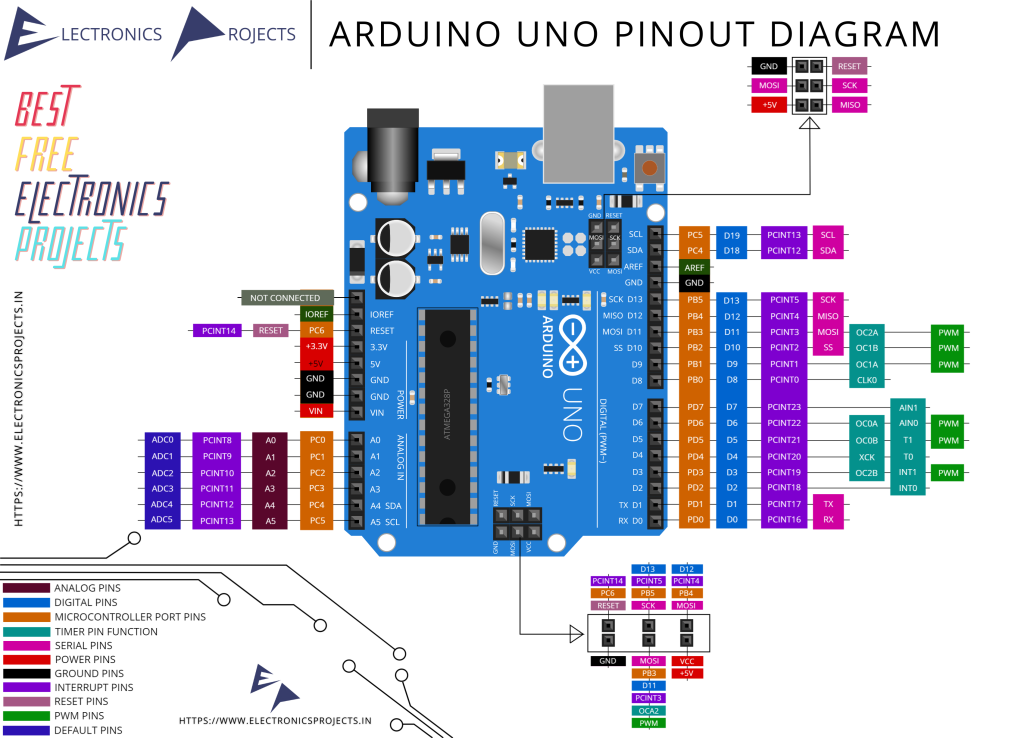Arduino UNO is a popular open-source microcontroller board based on the ATmega328P. It is widely used for various DIY electronics and robotics projects due to its ease of use, compatibility with a wide range of components and sensors, and affordable price. The board features 14 digital input/output pins, 6 analog inputs, a 16 MHz quartz crystal, and a USB connection for programming and power. The Arduino UNO pinout diagram is widely available and allows users to easily connect and control various components. Some of the key features of the Arduino UNO include support for C and C++ programming languages, a large and active user community, and compatibility with most Arduino shields and sensors. With its versatile capabilities, the Arduino UNO is a great choice for anyone looking to get started with electronics and microcontroller programming.
Here we are showing a highly detailed Arduino UNO pinout diagram and lots of general information about the board such as features, uses, advantages and applications.
Arduino UNO Pinout Diagram:

Download:
Size 1 MB | PNG Image
Features of Arduino UNO:
| SR. NO. | FEATURE | VALUE | INFORMATION |
|---|---|---|---|
| 1. | Microcontroller | ATmega328P | 8-bit AVR RISC-based |
| 2. | Operating Voltage | 5V | DC supply voltage |
| 3. | Input Voltage | 7-12V | External voltage (recommended) |
| 4. | Digital I/O Pins | 14 | 6 of them provide PWM output |
| 5. | Analog Input Pins | 6 | 10-bit resolution ADC |
| 6. | Clock Speed | 16 MHz | Quartz crystal oscillator |
| 7. | Flash Memory | 32 KB | 0.5 KB used by bootloader |
| 8. | SRAM | 2 KB | Dynamic memory for data storage |
| 9. | EEPROM | 1 KB | Non-volatile memory for storing data |
| 10. | Pinout | Standard 0.1″ DIP | Compatible with most shields and sensors |
| 11. | Programming Software | Arduino Integrated Development Environment (IDE) | Supports C and C++ programming languages |
| 12. | Connectivity | USB | USB connection for programming and power |
| 13. | Weight | 25 g | Lightweight and easy to use |
| 14. | Dimensions | 68.6 x 53.4 x 27 mm | Compact design |
| 15. | Current per I/O Pin | 40 mA | Maximum current per pin |
| 16. | Power Consumption | 20 mA | Low power consumption |
| 17. | Serial Communication | UART, SPI, I2C | Supports multiple communication protocols |
| 18. | Interrupts | 2 | External and Pin Change Interrupts |
| 19. | Debugging | In-circuit serial programming (ICSP) header | Supports debugging and programming |
| 20. | Operating Temperature | -40 to 85 °C | Wide operating temperature range |
| 21. | Operating System | None | Standalone operation |
| 22. | Expansion Shield Compatibility | Yes | Compatible with most Arduino shields |
| 23. | Power Jack | Yes | Accepts a barrel-type power plug |
| 24. | Reset Button | Yes | Resets the microcontroller |
| 25. | On-board LED | Yes | Indicates power and data transfer activity |
| 26. | ADC Resolution | 10-Bit | 0-1023 range for analog input readings |
| 27. | PWM Channels | 6 | Provides pulse-width modulation outputs |
| 28. | UART Channels | 1 | Supports serial communication |
| 29. | SPI Channels | 1 | Supports serial peripheral interface communication |
| 30. | I2C Channels | 1 | Supports inter-integrated circuit communication |
Physical Characteristics of Arduino UNO:
- Compact design with dimensions of 68.6 x 53.4 x 27 mm
- Lightweight, with a weight of 25 g
- Standard 0.1″ DIP pinout for compatibility with most shields and sensors
- On-board LED to indicate power and data transfer activity
- Reset button to reset the microcontroller
- Power jack for accepting a barrel-type power plug
Electrical Characteristics of Arduino UNO:
- Operating voltage of 5V DC
- Input voltage of 7-12V (recommended)
- Maximum current per pin of 40 mA
- Low power consumption of 20 mA
- Quartz crystal oscillator with a clock speed of 16 MHz
- Supports multiple communication protocols including UART, SPI, and I2C
- In-circuit serial programming (ICSP) header for debugging and programming
- Wide operating temperature range of -40 to 85 °C
Uses of Arduino UNO:
- Robotics and automation projects
- Home automation and control systems
- Internet of Things (IoT) applications
- Prototyping and testing electronic circuits
- Education and learning about electronics and programming
Advantages of Arduino UNO:
- Easy to use and beginner-friendly
- Open-source and community-driven, with a large user base and extensive documentation
- Compatible with most Arduino shields and sensors
- Supports C and C++ programming languages
- Affordable and readily available
Applications of Arduino UNO:
- Automated lighting systems
- Weather monitoring and data collection
- Remote control systems
- Motion detectors and alarm systems
- Games and interactive displays
- Measuring and monitoring temperature, humidity, and other environmental factors
- Controlling motors and servo motors
- Sensing and controlling humidity and water levels
- Automated plant and garden watering systems
